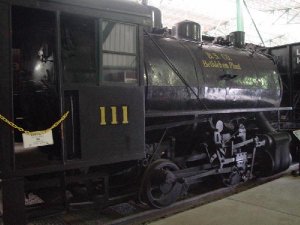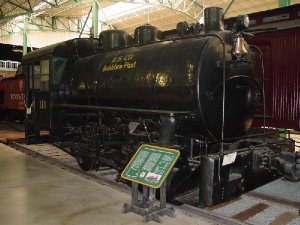Well I’m back, or should I say the Computer is awake & behaving now. 
I apologize again for the long delay in posting to the Builder’s Plate. Most of you have noticed I’ve posted to the other forums whenever I could lend a hand.
Well, I had a request from BDC for a Fireless Locomotive. But I am sorry to say I have never come across a pic of the “Charging Boilers”
The Railroad Museum of PA has a Heisler Fireless Cooker, also called a Thermos bottle. I guess I should start by reminding people why you would need a fireless loco to begin with. The answer is simple. If you need a power plant to pull freight and you work in what could be dangerous conditions, you do not want fire present. Thus the logging industry wanted just such an engine. Also Creosote Plants, Cotton Mills and Gunpowder Mills. (Gee who wouldn’t want an open fire near the gunpowder?)
The Fireless Boilers were simply “pressure vessels” in which the tanks were filled 4/5 full of hot water, then steam was added to about 170 PSI. This steam is used by the Cylinders at 60 PSI. As the steam is used, the water turns to steam, and so on until it needs to be recharged. The fireless boilers couldn’t wander very far from the steam recharging station.
It has been said that the "Fireless Cooker” was first built in Germany. The manufacturers in PA were:
- The Lima Locomotive Works, in Lima
- The Heisler Locomotive Works of Erie
- The H.K. Porter Co. of Pittsburgh
- The Vulcan Locomotive works of Wilkes-Barre
The Heisler pictured below, was built for the Bethlehem Steel in Bethlehem, PA.
Specs:
- 0-4-0 Switcher - 31" drive Wheels
- Built in 1940 (Heisler Loco Works, Erie, PA)
- Water Capacity: 420 Cubic Feet
- Weight: 70,000 Lbs
- Pull at drawbar: 11,800 Lbs
I apologize again for the long delay in posting to the Builder’s Plate. Most of you have noticed I’ve posted to the other forums whenever I could lend a hand.
Well, I had a request from BDC for a Fireless Locomotive. But I am sorry to say I have never come across a pic of the “Charging Boilers”
The Railroad Museum of PA has a Heisler Fireless Cooker, also called a Thermos bottle. I guess I should start by reminding people why you would need a fireless loco to begin with. The answer is simple. If you need a power plant to pull freight and you work in what could be dangerous conditions, you do not want fire present. Thus the logging industry wanted just such an engine. Also Creosote Plants, Cotton Mills and Gunpowder Mills. (Gee who wouldn’t want an open fire near the gunpowder?)
The Fireless Boilers were simply “pressure vessels” in which the tanks were filled 4/5 full of hot water, then steam was added to about 170 PSI. This steam is used by the Cylinders at 60 PSI. As the steam is used, the water turns to steam, and so on until it needs to be recharged. The fireless boilers couldn’t wander very far from the steam recharging station.
It has been said that the "Fireless Cooker” was first built in Germany. The manufacturers in PA were:
- The Lima Locomotive Works, in Lima
- The Heisler Locomotive Works of Erie
- The H.K. Porter Co. of Pittsburgh
- The Vulcan Locomotive works of Wilkes-Barre
The Heisler pictured below, was built for the Bethlehem Steel in Bethlehem, PA.
Specs:
- 0-4-0 Switcher - 31" drive Wheels
- Built in 1940 (Heisler Loco Works, Erie, PA)
- Water Capacity: 420 Cubic Feet
- Weight: 70,000 Lbs
- Pull at drawbar: 11,800 Lbs



